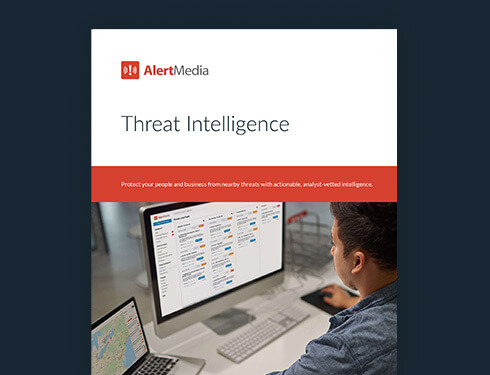
Actionable Intelligence: Identify, Verify, and Act With Confidence
Responding to emergencies with confidence requires actionable intelligence. In this post, we’ll discuss how you can determine if the threat intelligence you’re getting is actionable.

No matter what threat you encounter, responding effectively requires good intel. Information is everything when it comes to making good decisions during a crisis—but “good” intel might not be enough. In fact, the information you receive can be entirely true, verified, and from a trustworthy source but still do nothing to help you.
It’s like studying for a test. You can take the most detailed notes and study all night long, but if you’re reading the wrong chapter from the textbook, your preparation is a failure. You have to have more than just good information. You have to have the right good information.

In the threat intelligence and emergency management world, we call this “actionable intelligence.” When an emergency occurs, you need to have the right kind of intel to frame where, when, and how you deploy your emergency response resources.
Knowing there is a Category 3 hurricane making landfall in Florida is good intel. But knowing there are 150 mph winds, widespread flooding in Miami, and a delayed evacuation from coastal cities is actionable intel. You can respond specifically to the needs of your people in that area without wasting time or resources on the wrong move.
Having the right intel can make or break your response, but securing the necessary intel is not always straightforward. This article offers guidelines for what makes threat intelligence actionable so you can make better decisions about intelligence sources when the stakes are high.
What Is Actionable Intelligence?
Actionable intelligence is information about an event or situation that is detailed, contextualized, and strategic. With actionable intelligence, you have data and analysis of the data with enough surrounding context so you can immediately move to decision-making.
While other kinds of “intelligence”—like competitive intelligence and overall business intelligence—can provide you with information to understand a given situation, actionable intelligence enables you to step beyond understanding and into action. In an emergency situation, actionable threat intelligence is everything because understanding an emergency is not enough—you need to act to mitigate harm.
What Makes Threat Intelligence Actionable?
When an emergency situation emerges, the first step is to get intel about what’s happening. And the faster you can gather actionable threat intelligence, the faster you can begin your response.
But as with any crisis situation, knowing what intel is actionable isn’t always clear. Looking through crowded news feeds, sorting through raw data without any sort of visualization, or sifting through unverified reports can leave you feeling overwhelmed and unclear. You may also find intel but not be sure if it’s the kind of information you can use. So here are some questions to ask yourself when building out your data collection and analyzing your intel.

1. Is it from an authoritative source?
Actionable intelligence needs to be trustworthy, so make sure your information is coming from a trustworthy and authoritative source. While you might find information about an event quickly on social media sites like Twitter or Reddit, you will get better data from sources like government agencies (local, state, and national), news outlets, and emergency responders. These sources have the tools, resources, and experience to provide trustworthy data with accurate context.
Example: If a severe weather event is approaching, look to sources like the National Oceanic and Atmospheric Administration (NOAA) or the National Weather Service to get information about the event, as well as how you should respond.
2. Is it verified?
You don’t want to jump into action before you’ve checked that your information is true. After all, relying on bad threat intelligence can lead to disastrous outcomes. But it can be a challenge for you, a safety leader in the midst of an emergency, to fact-check reports during a rapidly developing situation. That’s why it’s critical for your organization to develop processes to guarantee information is verified, either internally or through trusted third-party sources—before you act upon it. You should take action only when a claim has been substantiated; otherwise, you risk spending a significant amount of time, money, and energy responding to a threat that isn’t real or sending out unreliable information that will only undermine the credibility of your team.
Fortunately, there are a few ways to get verified intel. You can simply spend the time combing through different data sources until you find enough evidence to support a claim, or you can use a threat intelligence system that does the verification work for you. The primary benefit of these systems is they collect data from thousands of sources, corroborate information either using intelligence experts or data science (e.g., machine learning, artificial intelligence, etc.), and then provide only the most trustworthy information to you—essentially removing the lion’s share of the leg work.
Pro Tip: Many threat intelligence providers rely exclusively on artificial intelligence to sort through and verify their intel. While artificial intelligence software can be very helpful when breaking down big data pools, you should look for a system that also leverages real human analysts who can independently identify and verify things AI might miss. Having trained experts on hand is also helpful if you need to follow up to get more context about a threat.
3. Is it relevant?
Having tons of details about an event does nothing for you if it’s not relevant to your specific business or situation. For example, if you have employees working on a local construction site when a major storm hits, knowing about something like flight cancellations isn’t going to help you protect your workers. It would be much more helpful to know that the creek down the street has flooded and cars cannot pass.
You also want to avoid running into so-called information overload, being flooded with too much information that isn’t all relevant when sourcing your intelligence. It can be difficult to do on your own, but filtering out the noise is the only way to get down to actionable information.
4. Is it timely?
Just like with relevance, you need to have intel that is timely in order for it to be actionable. You don’t want to get intel too late to do anything. Ideally, you’ll have plenty of time to deploy a response, instead of scrambling last minute or worse, learning about something too late to act. Timeliness is especially important during emergencies when the situation is often changing rapidly and your response needs to be able to shift with it.
Emergency response can come down to by-the-second actions, so having the right data at the right time is critical to keeping your business operational and your employees safe. The best way to ensure you have timely information is to use a threat monitoring system with real-time threat dashboards. You want to be able to track events as they are happening, so you always have the most up-to-date insight to inform your response.
Automate Your Intelligence Gathering
Sorting through headlines during an emergency situation can be as frustrating as it is time-consuming. And you don’t want to spend precious minutes trying to verify a source or decide if a piece of information is outdated or not. Optimize your emergency management with an automated threat intelligence system that can do the leg work for you. That way you can focus on using that actionable intelligence to protect your people and business operations.




